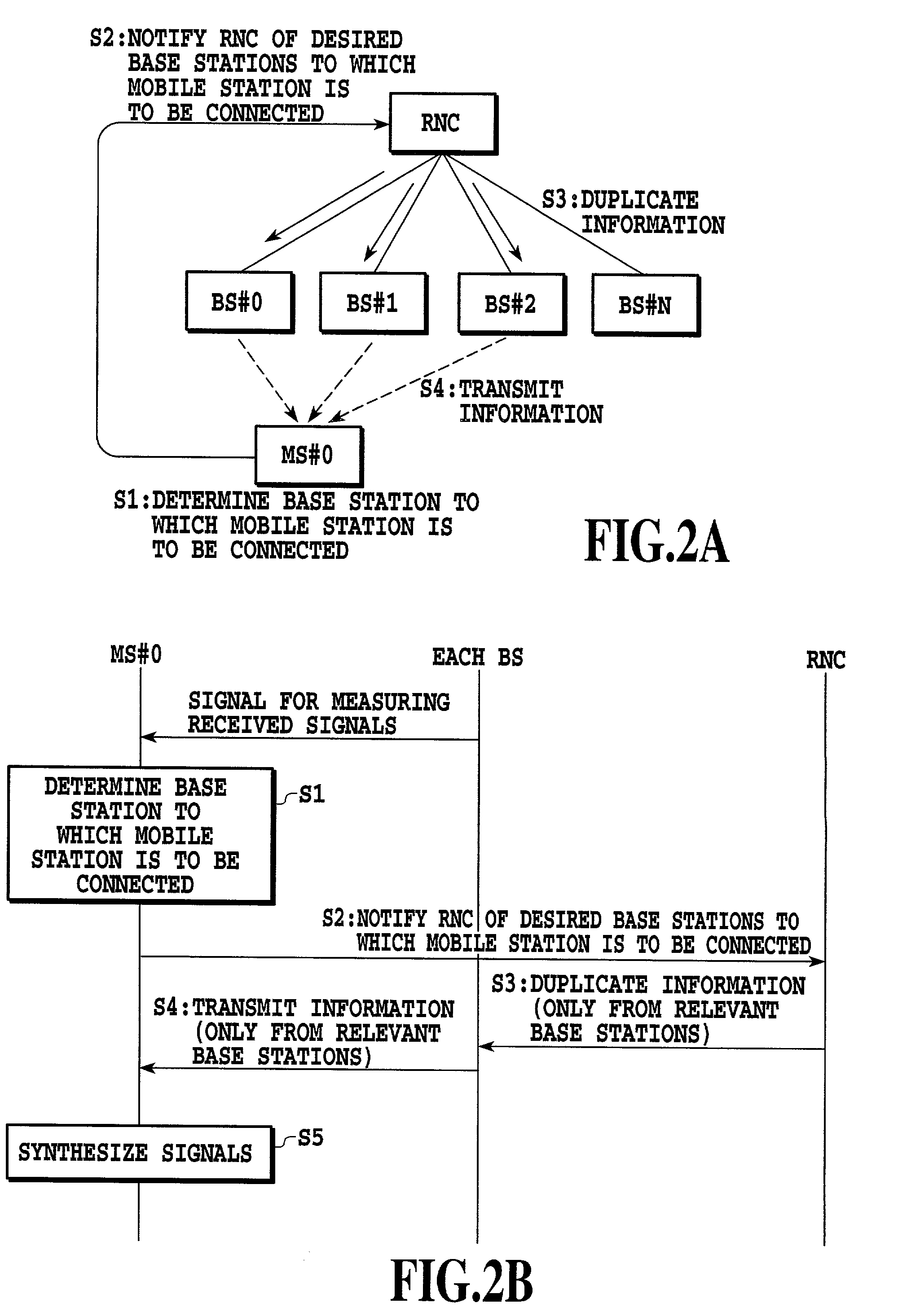Mobile communication system and method for controlling receiving quality
- Summary
- Abstract
- Description
- Claims
- Application Information
AI Technical Summary
Benefits of technology
Problems solved by technology
Method used
Image
Examples
embodiment 1
[Embodiment 1]
[0044]FIG. 2A shows a mobile communication system for implementing receiving quality control for a downlink. In this figure, reference characters RNC, BS, and MS denote a radio network controller, a base station, and a mobile station, respectively. More specifically, FIG. 2A shows how the base station BS (including base stations #0 to #N), the mobile station MS#0, and the radio network control station RNC are connected together according to Embodiment 1, and FIG. 2B shows the flow of communication control according to Embodiment 1.
[0045]In Embodiment 1, the mobile station MS#0 measures power received from surrounding base stations to determine to which base stations it is to be connected in order to satisfy a desired downlink receiving quality (step S1).
[0046]The mobile station MS#0 notifies the radio network control station RNC of the desired base stations to which it is to be connected, using the signal format shown in FIG. 3 (step S2). FIG. 3 shows the signal format...
embodiment 2
[Embodiment 2]
[0050]FIG. 4A shows another mobile communication system for implementing receiving quality control for the downlink. This system comprises a QoS (Quality of Service) agent in addition to the radio network control station RNC, the base station BS, and the mobile station MS. More specifically, FIG. 4A shows how the base station BS (including base stations #0 to #N), the mobile station MS#0, the radio network control station RNC, and the QoS agent are connected together according to Embodiment 2, and FIG. 4B shows the flow of communication control according to Embodiment 2.
[0051]In Embodiment 2, the mobile station MS#0 notifies the QoS agent of a downlink receiving quality desired thereby and the location thereof, using the signal format shown in FIG. 5A (step S11). FIG. 5A shows the signal format used by the mobile station MS#0 to notify the QoS agent (=signal indicative of a desired receiving quality and information on the location of the mobile station). This signal fo...
embodiment 3
[Embodiment 3]
[0059]FIG. 8A shows a mobile communication system for implementing receiving quality control for an uplink. This system comprises the radio network control station RNC, the base station BS, the mobile station MS, and the QoS agent. More specifically, FIG. 8A shows how the base station BS (including base stations #0 to #N), the mobile station MS#0, the radio network control station RNC, and the QoS agent are connected together according to Embodiment 3, and FIG. 8B shows the flow of communication control according to Embodiment 3.
[0060]In Embodiment 3, before transmitting information, the mobile station MS#0 transmits a desired uplink quality received by base stations and the location and transmittable maximum power of the mobile station, to the QoS agent using the signal format shown in FIG. 9A (step S41). The QoS agent selects base stations to which the mobile station is to be connected in order to satisfy this quality in such a way that the transmittable maximum powe...
PUM
 Login to View More
Login to View More Abstract
Description
Claims
Application Information
 Login to View More
Login to View More - R&D
- Intellectual Property
- Life Sciences
- Materials
- Tech Scout
- Unparalleled Data Quality
- Higher Quality Content
- 60% Fewer Hallucinations
Browse by: Latest US Patents, China's latest patents, Technical Efficacy Thesaurus, Application Domain, Technology Topic, Popular Technical Reports.
© 2025 PatSnap. All rights reserved.Legal|Privacy policy|Modern Slavery Act Transparency Statement|Sitemap|About US| Contact US: help@patsnap.com



